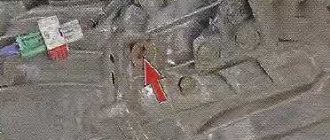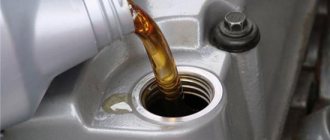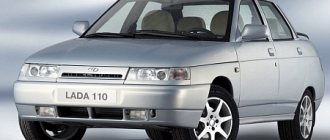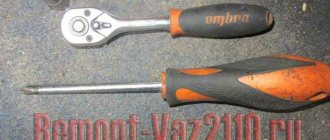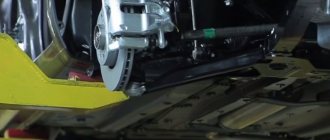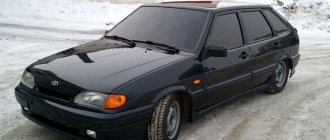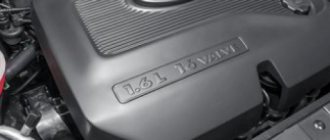The stylish Geely MK Cross, with its outstanding appearance and attractive technical characteristics, has already won the hearts of many Russian motorists. Although calling this model a full-fledged crossover can only be a stretch, a car in a hatchback body can surprise consumers with increased ground clearance and affordability.
You can buy Geely MK Cross in Russia in two trim levels. You should not expect outstanding dynamics from the “Chinese”, because the car is equipped with a four-cylinder 16-valve gasoline engine with a capacity of 94 hp. With. and volume 1.5 l. This is a Toyota 5A-FE engine, which has proven itself exclusively on the positive side. This power unit is combined with a manual transmission.
A Chinese car with economical fuel consumption will be a good find for a family with frequent out-of-town trips. A hatchback for an active lifestyle feels quite confident on Russian roads, so it is an excellent choice for outdoor trips or long-distance travel. In addition, the Geely MK Cross is characterized by decent build quality, safety, and good equipment compared to more expensive competitors.
Spare parts for Geely MK Cross with delivery
For many foreign cars, purchasing spare parts in Russian cities is not always easy. The meager assortment and inflated prices force car owners to look for an alternative or buy parts online.
You can order engine spare parts for the Geely MK Cross in the Agatol online store. Our catalog contains a wide range of parts, consumables, components, and accessories. Buyers from any region of the Russian Federation can purchase everything necessary for repair, tuning or maintenance from us. Spare parts for Geely MK Cross engine
can be selected from availability by performing an online search on the website. But even if the required items are not available at the moment, our company will always supply spare parts for Chinese models from warehouses in Moscow or from China.
The engine is all the strength and power of the car. All car enthusiasts are primarily interested in its stable, reliable operation.
The Geely MK Cross uses a variation of the Toyota 5A-FE engine, similar to that used on the Toyota Corolla A100. The Toyota Corolla A100, in turn, was famous for the reliability and quality of the Japanese automobile industry.
The Geely MK Cross engine is equipped with a DOHC gas distribution system, four-cylinder type. The engine capacity is small 1.5 liters, power 94 hp, at 6 thousand rpm. With this set of characteristics, you can accelerate the car to a speed of 165 km/h. The engine has 16 valves. An experienced driver will accelerate to 100 km/h in 17 seconds. Engine filling is economical.
Engine Geely MK Cross - spare parts
The stylish Geely MK Cross, with its outstanding appearance and attractive technical characteristics, has already won the hearts of many Russian motorists.
Although calling this model a full-fledged crossover can only be a stretch, a car in a hatchback body can surprise consumers with increased ground clearance and affordability. You can buy Geely MK Cross in Russia in two trim levels. You should not expect outstanding dynamics from the “Chinese”, because the car is equipped with a four-cylinder 16-valve gasoline engine with a capacity of 94 hp. With. and volume 1.5 l. This is a Toyota 5A-FE engine, which has proven itself exclusively on the positive side. This power unit is combined with a manual transmission.
A Chinese car with economical fuel consumption will be a good find for a family with frequent out-of-town trips. A hatchback for an active lifestyle feels quite confident on Russian roads, so it is an excellent choice for outdoor trips or long-distance travel. In addition, the Geely MK Cross is characterized by decent build quality, safety, and good equipment compared to more expensive competitors.
timing belt
The mechanism uses a belt drive. Typically, replacing the belt drive is required after 60 thousand mileage. After 40 thousand km. It is advisable to check its condition; it may be necessary to replace the drive earlier, for some even after 60 thousand km. it is in perfect condition.
Sometimes the rear engine mount fails, this becomes noticeable by knocking and vibration while the car is moving. However, repairing the rear engine mount will not be difficult, the main thing that needs to be done is to unscrew the rear mount of the Geely MK Cross engine from the engine bracket and remove the bolt, then perform the standard steps for unscrewing and loosening the bolts, then insert a new spare part.
We see that this engine is a little difficult to operate. It is necessary to frequently analyze its condition. However, despite everything, we can say that this mechanism is of high quality and economical to maintain.
Gili MK is a Chinese representative of the small class. During its development, the first generation Toyota Vios was taken as a basis, which in turn is nothing more than a redesign of the first Toyota Yaris. This explains the almost complete similarity of the chassis with the Yaris produced in 1999-2002, and the 1.5 liter engine is a licensed copy of Toyota’s 5A-FE.
Geely MK appeared in Russia in June 2008. The first Gili came to showrooms straight from China. Since 2010, Geely MK began to be assembled in Cherkessk, at the Derways enterprise.
Features of operation
Fuel consumption
Unfortunately, it is almost impossible to meet the requirements under real operating conditions. And, if after running on the highway you manage to get closer to the desired result, then in the city the average consumption per hundred kilometers will be 9-10 liters , with a very leisurely drive and without sudden acceleration. Otherwise, you can add a couple more liters on top.
Oil
Engine oil is changed as standard, once every ten thousand kilometers or once every twelve months. Both the factory and car owners recommend pouring synthetic, with a viscosity index of 5w40 . As a rule, services are filled with Shell or Castrol .
timing belt
The gas distribution mechanism is equipped with a belt drive. It is changed at 60 thousand mileage , but it is better to check the condition after 40,000 km . Replacement may be required earlier, but it happens that even after 60 thousand the belt is almost not worn out.
When the timing belt teeth slip or break, the valve , as a rule, does not bend . Although no one is immune from exceptions. Therefore, it is better not to start the condition of the timing belt. The valves require adjustment every 40 thousand km.
Engine
The Geely MK engine has a timing belt drive. From experience, it doesn’t hurt to check the condition of the belt after 40-50 thousand km. Some do not show the slightest signs of wear after 60,000 km, while others may be missing a couple of teeth, and the belt turns out to be covered with cracks. Fortunately, when the valve belt breaks, the pistons and valves do not collide. When replacing the timing belt, the right engine mount must be removed.
During a cold start, the Geely MK engine often begins to “trouble.” The problem can be solved after replacing spark plugs, high-voltage wires, ignition coils (1,000 rubles) or adjusting the valves. When removing high-voltage wires, owners often tear them off. Neglecting valve adjustment is fraught with the risk of them “squeezing” with a mileage of more than 40-60 thousand km and subsequent burnout. Burnouts are more common on cars with installed gas equipment.
Over time, the gasket on the throttle heating begins to leak antifreeze. When the coolant dries out, it contaminates the idle air regulator channel and the regulator itself. The result is difficult starting, the engine stalls immediately after setting and starts only with the gas pedal depressed. To prevent leaks from occurring, after cleaning the channel, it is better to seal the throttle gasket with a heat-resistant sealant. A new original idle air control costs about 1,000 rubles; an analogue for a Chevrolet Niva for 500 rubles is suitable as a replacement.
The Geely MK engine is prone to overheating in the warm season during prolonged driving at speeds of more than 100 km/h with the air conditioning turned on. The problem appears when the mileage is more than 40-50 thousand km. One of the reasons is the cooling fan not working due to poor contact at one of the three ground wire attachment points. Overheating can also be caused by late opening of the thermostat and the peculiarity of the engine ECU, which gives the command to turn on the fan already at critical values of the coolant temperature. The coolant temperature sensor itself may produce incorrect values due to souring of the contact terminals. “Underheating” or a long warm-up of the engine indicates that the thermostat is souring in the open position, which is also not uncommon. A new thermostat costs about 200 rubles.
Some owners are faced with the need to replace a blown cylinder head gasket. The engine liquid cooling pump may fail after a mileage of more than 50-100 thousand km. The appearance of rust-colored spots in the expansion tank causes confusion. In cold weather, cooling radiators often leak at the junction of plastic and metal.
The exhaust system O-ring at the junction of the exhaust manifold with the pipe often has to be replaced due to burnout. With a mileage of more than 80-120 thousand km, the front crankshaft oil seal begins to leak. The oil pressure sensor may fail after a mileage of more than 50-60 thousand km.
The rear engine mount runs for more than 40-60 thousand km, after which it starts knocking. A new support will cost 1.5-2 thousand rubles.
After 150-200 thousand km, oil consumption often increases. It is not always possible to eliminate oil leaks simply by replacing the valve stem seals. Often stuck rings are also to blame. A set of rings and caps is available for 4,000 rubles.
Features of the 1.5-liter Geely engine
The Chinese brand Geely is quite popular among Russian car enthusiasts. Despite the fact that it has to compete with the super-successful VAZ models, it feels pretty good in the budget car segment and has almost Napoleonic plans to further capture the market. The success of this manufacturer has several components. One of the most significant of them can be considered the use of licensed engines from Toyota. Indeed, in Russia there is a special attitude towards motors of Japanese brands - they are considered the standard of reliability and longevity. Do their Chinese copies have the same qualities? Let's try to find out.
One of the most common licensed Toyota engines installed on Geely is a 1.5-liter unit with a capacity of 94 horsepower. It is a slightly modified variation of the Toyota 5A-FE engine, which was equipped with the 7th and 8th generation Corollas. Geely engineers optimized this engine for several models, which are the most popular on the Russian market. If you go, for example, to a site selling Gili, you will be able to see that more than half of the SK, MK and Emgrand cars presented are equipped with this particular one and a half liter unit.
This motor has been used in Russian conditions for quite a long time, so we can draw some conclusions about its reliability and characteristics. We can say right away that the motor is definitely not a “millionaire”. However, in fairness it is worth noting that its Japanese prototype also did not lay claim to the coveted resource of a million kilometers. In general, the experience of domestic motorists shows that with proper care the engine will travel 150-200 thousand km before being overhauled, and then about the same amount before a major overhaul. The result is quite good, considering the current trends in the production of “disposable” motors.
The unit also has the following features:
- On Geely cars of the early years of production, there was a problem with piston oil scraper rings. They wore out quickly, which led to increased oil consumption. If the car owner did not have time to discover that the engine in his car was running “dry,” then very often he was faced with an unfortunate phenomenon known as “the engine knocked.” As a result, it was necessary to either do a major overhaul or completely change the engine.
- When the timing belt breaks, the valves, as a rule, do not meet the pistons. But you shouldn’t hope for this - it’s better to check the condition of the belt every 40 thousand km and replace it immediately if defects are found.
- Fuel consumption rarely corresponds to the passport 7 liters per 100 km. In the city, the engine's appetite is approximately 9-10 liters per hundred.
Despite a number of shortcomings, the Geely 1.5 liter engine can be considered a good unit. Its important advantage is the ability to use Toyota parts for current and major repairs.
Transmission
The 5-speed manual transmission on the new Geely MK suffers from poor gear shifting for the first few thousand kilometers. Afterwards, the elements of the box “roll in”, and there are no problems with the ease of shifting gears. A significant contribution to poor speed selectivity is made by “cheap” oil poured into the box during assembly. This “transmission” thickens greatly in the cold. After changing the working fluid, the performance of the box improves.
With a mileage of more than 50-70 thousand km, the box begins to make noise. The reason is wear of the bearings of the primary and secondary shaft. It is noteworthy that in the warranty book the box bearings are listed as a separate item, and the warranty for them is only 30 thousand km. For the work of removing and installing the box you will have to pay about 3 thousand rubles, for the bulkhead - about another 4 thousand rubles, a set of new bearings will cost 1-2 thousand rubles.
The clutch lasts for more than 90-120 thousand km. A new set with a basket and release bearing will cost 3-5 thousand rubles. With a mileage of more than 100,000 km, the gearbox often begins to make noise when releasing the gas in third gear.
Drive seals can leak after 30-40 thousand km. The cost of the drive oil seal is about 500 rubles. After 50-60 thousand km, it may be necessary to replace the clutch master cylinder. A leaking cylinder can be restored using a repair kit for 600 rubles.
The boots of the outer CV joint will most likely have to be replaced when the mileage exceeds 100-120 thousand km. It will not be possible to find original anthers separately, since they are sold only complete with the drive. But finding an analogue in a spare parts store for other car brands will not be difficult.
Chassis
The Geely MK suspension is not particularly durable. The front stabilizer struts are the first to go - after 20-30 thousand km. Stabilizer bushings last a little longer - about 40-60 thousand km. Shock absorbers may leak or knock after 30-60 thousand km. The cost of a new one is in the range of 1.5-2.5 thousand rubles. Front wheel bearings last more than 60-80 thousand km. The ball and suspension arms travel the same amount. A new ball costs about 800 rubles.
Due to the “crooked” assembly, the steering rack has lateral play, which can be removed after tightening. Often the rack begins to leak after 50-100 thousand km. The cost of a new rail is about 15-20 thousand rubles. Steering rods and ends last more than 50-80 thousand km. Sometimes the power steering pump also fails.
Due to corrosion of the piston coating of the front caliper brake cylinder, the brakes may jam when the mileage is more than 50-70 thousand km. The repair kit will cost 400 rubles. Sometimes the rear brake cylinders begin to “poison” the brake fluid.
Body and interior
The body of the Geely MK does not resist corrosion well. The first lesions inevitably appear on chips. And after 1-2 years of operation, in the lower corner of the front doors under the seal, in the area of the trunk lid lock, gas tank flap and on the inner surface of the hood. Later, the wheel arches and sills begin to rot. Cars with a factory sunroof are most susceptible to sill corrosion. Engineers brought the hatch drains directly into the thresholds. You will have to pay over 30 thousand rubles to repair the thresholds.
Headlights and taillights often fog up, and foglight lenses often break when used in cool, damp weather.
The hard plastic interior of the Geely MK is very creaky, especially in cold weather. A rattling sound in the steering wheel may occur due to the screws holding the airbag unit loosening over time. A loose steering shaft seal allows noise from the engine and exhaust system into the cabin.
One of the problems of the Geely MK is water in the cabin. It gets there due to poorly taped windshield and rear windows, as well as through flying rubber plugs on the bottom. Water accumulates in the trunk due to the rear light seats and rear shock absorber mounts. Water can also enter through ventilation valves.
The operation of the climate control system also causes a lot of criticism. The air conditioner becomes ineffective when the ambient temperature exceeds 25-30 degrees Celsius. This is facilitated by the design feature of the heating system: hot tubes and the heater radiator are located directly under the panel. Even in cool weather with the air conditioner and temperature controller turned off, warm air flows from the deflectors in the cold sector.
With a mileage of more than 100,000 km, leaks in the air conditioning system are detected more and more often. The air conditioning compressor (about 9-12 thousand rubles) may jam after 50-100 thousand km. The heater fan sometimes stops turning on or changing rotation speed due to the failure of the relay (rheostat) of the fan speed controller. The new regulator is not expensive - about 400 rubles.
Other problems and malfunctions
Unfortunately, the body metal of the MK Cross has poor corrosion resistance. The first rust begins to appear from under the plastic door sills after 3-4 years. Soon, rust spots are found on the hood, doors, roof, rear wheel arches and under the headlights on the fenders.
Electrically heated mirrors often fail (200-500 rubles per mirror element). There are also problems with the electronic instrument panel - the indication disappears. The device comes to life after soldering the board.
The generator can also get sick: the voltage regulator fails, or the brushes wear out.
There are difficulties with the stove motor (3,000 rubles) or its rheostat (900 rubles).
The heater radiator may leak or become clogged with sludge after 50-100 thousand km. The Toyota analogue is available for 2,000 rubles. The replacement process is labor-intensive. To access the radiator, you need to disassemble the front panel. For work in the service they will ask about 5,000 rubles.
From time to time, the cables for adjusting the air flow and the heater valve come off.
Electrical equipment
Problems with charging current may appear after 80-120 thousand km. The reason is a failure of the voltage regulator. A set of a new relay and brushes will cost 2.5-3.5 thousand rubles. A new generator costs about 4.5-5.5 thousand rubles.
Due to the short circuit of the temperature sensor of the seat heating element or the “sticking” of the heating button, the heated front seats may stop working. Factory heating elements for heating mirrors do an excellent job, but they often fail. After replacing the mirrors with an analogue one, the heating becomes less effective, but much more durable.
With a mileage of more than 100-150 thousand km, a break in the steering column wiring harness is possible. There are also frequent problems with the dashboard lighting. The reason is the failure of the driver board microcircuit for the electric motors that control the movement of the arrows and the lighting of the devices. The cost of a new tidy is about 7-8 thousand rubles.
Description and performance indicators of the MR479QA motor
Advancement in the automotive market is impossible without the development of modern engines. With the release of the MR479QA power plant, Geely showed the seriousness of its intentions to expand sales to the markets of Europe and Asia. Carefully calculated power ratings and maintainability have made engines made in China quite reliable for long-term operation. This engine uses BOSCH electronic control and a lot of technical solutions from Toyota.
The parameters of the MR479QA engine allow you to experience all the benefits of high-tech production. The power plant has much in common with the 5A-FE engine used in the Toyota Corolla, but the Geely MR479QA cannot be called a full replica of the Japanese engine. Most of its features have been changed to avoid lawsuits, but the internals and attachments are virtually identical. Among the features of the MR479QA are its low cost and low noise level in operation.
MR479QA Engine Specifications
All indicators of the power plant are precisely calculated and allow you to feel confident when driving the car. The engine design is a four-cylinder in-line design with a fuel injection system. The vertical cylinder arrangement and DOHC gas distribution system complement the engine's characteristics. This technology allows the use of 2 camshafts to service the cylinder head. The crankshaft in the MR479QA engine is mounted on reinforced main bearings and has rigid fixation to prevent axial vibrations.
The MR479QA engine has valve adjustments that must be performed regularly to prevent more serious damage. The cylinder head itself is made of aluminum alloy, and the intake and exhaust ports are on opposite sides. The remaining technical characteristics also deserve a little attention.
- The cooling system is closed and has no direct communication with the external environment. To prevent pressure drops, an expansion tank is used. The pump is equipped with a drive coming from the crankshaft, which ensures the circulation of coolant;
- Lubrication system - combined design guarantees a stable supply of oil under pressure for all components operating under load. Oil is supplied to the remaining elements by gravity or splashing;
- Flywheel - has a crimped toothed rim, which serves to start the engine with a starter. The flywheel itself is made of cast iron;
- Ignition is built on microprocessor control, ensuring high accuracy. The ignition module does not require adjustment, and spark plugs for the MR479QA engine can be used of iridium or conventional type.
The timing system is typical for an internal combustion engine of this design and uses a belt drive. Despite the similarity with the 4A-FE engine, spare parts from Toyota are not suitable for all, and you should carefully study the service manual or buy original parts.
Engine MR479QA Geely MK / MK Cross
The Geely MK car is equipped with a transversely mounted four-stroke four-cylinder petrol injection 16-valve engine with a displacement of 1.5 liters.
The engine is with in-line vertical cylinders, liquid cooling.
The exhaust camshaft is driven by the timing belt, the intake camshaft is driven by the exhaust camshaft using helical gears mounted on the camshafts. Replacing the timing belt, see here Replacing the exhaust camshaft oil seal, see here Replacing camshafts, see here The cylinder head is made of aluminum alloy in a transverse pattern for purging the cylinders (intake and exhaust channels are located on opposite sides of the head). Valve seats and guides are pressed into the head. The intake and exhaust valves have one spring each, fixed through a plate with two crackers. A non-shrinkable metal-reinforced gasket is installed between the block and the head. In the upper part of the cylinder head there is a common bed of bearing supports for two camshafts (intake and exhaust). The upper bed covers of the bearing supports are attached to the block head with bolts that secure the bed covers to the base of the bed. The holes of the sliding bearing supports (bed) are processed together with the covers, so the covers are not interchangeable; each cover is marked with a serial number. Replacing oil seals, see here Replacing the cylinder head gasket, see here Replacing cylinder head cover gaskets, see here Installing the piston of the first cylinder to the TDC position of the compression stroke, see here Checking and adjusting the clearances in the valve drive, see here
block is a single cast iron casting that forms the cylinders, cooling jacket, lubrication system and five crankshaft bearings. At the bottom of the block there are five beds of main bearings. The cylinder block has special bosses, flanges and holes for fastening parts, assemblies and assemblies, as well as channels for the main oil line. Checking, adjusting and replacing drive belts, see here
The crankshaft rotates in main bearings that have thin-walled steel liners with an anti-friction layer. The engine crankshaft is secured against axial movements by two half-rings installed in the grooves in the bed of the middle main journal bearing. Removal, troubleshooting and installation of the crankshaft, see here. Replacement of crankshaft oil seals, see here.
The flywheel is cast iron, mounted on the rear end of the crankshaft through a mounting sleeve and secured with six bolts. A toothed rim is pressed onto the flywheel to start the engine with a starter. The flywheel has a gear ring for the crankshaft position sensor. Replacing the flywheel, see here
The pistons are made of aluminum alloy. On the cylindrical surface of the piston head, annular grooves are made for one oil scraper ring and two compression rings. The pistons are additionally cooled by oil supplied through a hole in the upper end of the connecting rod and sprayed onto the piston crown. For defective parts of the connecting rod-piston group and cylinder block, see here. Replacement of parts for the connecting rod-piston group, see here.
The piston pins are installed in the piston bosses with a gap and pressed with an interference fit into the upper heads of the connecting rods, which with their lower heads are connected to the crankpins of the crankshaft through thin-walled liners, the design of which is similar to the main ones.
The connecting rods are steel, forged, with an I-section rod.
The lubrication system is combined: the most loaded parts are lubricated under pressure, and the rest - either by directed splashing or by splashing oil flowing from the gaps between the mating parts. Replacing the oil sump seal, see here Replacing the oil and oil filter, see here Replacing the oil pump, see here Replacing the interior heater valve, see here
crankcase ventilation system does not communicate directly with the atmosphere, therefore, simultaneously with the suction of gases, a vacuum is formed in the crankcase under all engine operating modes, which increases the reliability of various engine seals and reduces the emission of toxic substances into the atmosphere.
cooling system is sealed, with an expansion tank, and consists of a cast cooling jacket surrounding the cylinders in the block, combustion chambers and gas channels in the cylinder head. Forced circulation of coolant is provided by a centrifugal water pump driven from the crankshaft by a poly-V-belt, which simultaneously drives the generator pulley. To maintain the normal operating temperature of the coolant, a thermostat is installed in the cooling system, which closes a large circle of the system when the engine is not warmed up and the coolant temperature is low. Replacing the expansion tank, see here Replacing the water distribution box, see here Replacing the thermostat, see here Replacing the water pump, see here Replacing the electric radiator fan, see here Replacing the radiator, see here Replacing the coolant, see here
power system consists of an electric fuel pump installed in the fuel tank, a throttle assembly, coarse and fine fuel filters, fuel lines and injectors, and also includes an air filter. Replacing the thermal screens of the exhaust system, see here Replacing the main muffler, see here Replacing the additional muffler, see here Replacing the exhaust pipe, see here Replacing the exhaust manifold, see here Replacing the exhaust system suspension cushions, see here Replacing the throttle pedal, see here Replacement throttle cable, see here Replacing the idle air control, see here Replacing the throttle assembly, see here Replacing the air filter housing, see here Replacing the air filter, see here Replacing the intake manifold gasket, see here Replacing the canister purge solenoid valve, see here Replacing the canister fuel vapor recovery systems, see here Replacing the filling pipe, see here Replacing the fuel tank, see here Replacing and checking injectors, see here Replacing the fuel pressure regulator, see here Replacing the fuel rail, see here Replacing the fuel filter, see here Replacing the fuel pump, see here Checking and reducing pressure in the power system can be found here
The design of the intake manifold with independent long channels allows the use of the effect of inertial charging.
ignition system is microprocessor-based and consists of a four-terminal ignition coil (module), high-voltage wires and spark plugs.
The ignition module is controlled by the electronic unit (controller) of the engine management system. The ignition system does not require maintenance or adjustment during operation.
The power unit (engine, clutch and gearbox) is mounted on three supports with elastic rubber elements: two side ones (right and left), which absorb the bulk of the power unit, and a rear one, which compensates for the torque from the transmission and the load that occurs when the car starts moving. , acceleration and braking. Replacement of engine mudguards, see here Replacement of engine mounts, see here
| MR479QA Specifications | |
| engine's type | 4-stroke, in-line 4-cylinder, 16-valve, water-cooled, dual counter-rotating camshafts |
| Combustion chamber type | Wedge-shaped |
| Inner diameter of the cylinder, mm | 78,7 |
| Piston stroke, mm | 77 |
| Cylinder volume, l | 1,498 |
| Compression ratio | 9,8 |
| Compression pressure (compression), kPa, not less | 980 |
| Permissible pressure difference in cylinders, kPa, no more | 100 |
| Oil volume, l | 3.0 |
| Fuel | Unleaded gasoline with an octane rating of at least 93 |
| Cylinder operating order | 1-3-4-2 |
| Shaft rotation direction (front view) | Clockwise |
| Lubrication system | Spray under pressure |
| Cooling system | Forced type |
| Thermostat valve opening temperature, °C | 82 |
| Full opening temperature of the thermostat valve, °C | 95 |
| Crankshaft rotation speed corresponding to maximum power, min-1 | 6000 |
| Maximum power, hp | 94 |
| Maximum torque at rpm, Nm | 128 |
| Crankshaft rotation speed corresponding to maximum torque, min-1 | 3400 |
| Idle speed, min-1 | 800±50 |
| Intake valve clearance on a cold engine, mm | 0,20±0,03 |
| Valve clearance of the exhaust valve on a cold engine, mm | 0,30±0,03 |
| Engine (front view): 1 — drive belt for generator and water pump; 2 — bracket for fastening the right suspension support of the power unit; 3 - generator; 4 — oil filler plug; 5 — throttle assembly; 6 - high voltage wire; 7 — cylinder head cover; 8 — intake manifold; 9 — cylinder head; 10 — inlet pipe of the engine cooling system; 11 — ignition module; 12 — water distribution box; 13 — crankshaft position sensor; 14 — left suspension support of the power unit; 15 — working cylinder of the hydraulic clutch release; 16 — control oxygen concentration sensor; 17 — exhaust manifold; 18 — oil filter; 19 — oil sump; 20 — air conditioning compressor; 21 — air conditioning compressor drive belt |
| Engine (rear view): 1 — gearbox; 2 — ignition module; 3 — clutch housing; 4 - water distribution box; 5 - fuel rail; b — intake manifold; 7 — absolute pressure sensor in the intake manifold; 8 — throttle assembly; 9 — throttle position sensor; 10 — idle speed regulator; 11 — oil dipstick guide; 12 — power steering pulley; 13 — power steering pump; 14 — oil sump; 15 — knock sensor; 16 — cylinder block; 17 — starter; 18 — bracket for fastening the rear suspension support of the power unit; 19 - vehicle speed sensor |
| Engine (right view): 1 - absolute pressure sensor in the intake manifold; 2 - fuel rail; 3 — oil filler plug; 4 — cylinder head cover; 5 - generator; b — tensioner for the generator and water pump drive belts; 7 — air conditioning compressor; 8 — air conditioning compressor drive clutch; 9 — tension roller of the air conditioning compressor drive belt; 10 - oil sump; 11 — crankshaft pulley; 12 — water pump pulley; 13 — power steering pump pulley; 14 — tensioner of the power steering pump drive belt; 15 — oil dipstick guide; 16 — intake manifold; 17 — idle speed regulator; 18 - throttle position sensor |
The information is valid for MK models from 2006 to 2015, and for MK Cross models from 2011 to 2016.
Geely MR479QA engine maintenance
To create optimal conditions for engine operation, all recommendations of the manufacturer should be followed. Such information can be found in the user manual, indicating the timing and required maintenance procedures. With significant mileage, you should pay closer attention to the car, and a simple replacement of the valve stem seals can protect the cylinder head from major repairs. Items such as the air filter or fuel system also require maintenance that should not be forgotten.
For any car, changing the oil is of great importance. The driver should definitely know what kind of oil can be poured into the engine. In this regard, Geely is quite universal and the oil for MR479QA is 10w40 and 10W30. In winter, it is also possible to use 5w30. The engine manufacturer recommends replacing it after 10 thousand km, but the real need may arise after 5-7 thousand km. Oil control can be easily done using a dipstick, which will show its level and degree of production.
Diagnose the Geely MK Cross engine
If something is wrong with the Geely MK Cross, then “Check-Engene” does not go out, or lights up again after a while. It may also blink, which clearly indicates a serious malfunction. This indicator will not tell the Gili owner what exactly the problem is; it draws attention to the fact that diagnostics of the Gili MK Cross engine is required.
Since all foreign cars, not excluding the Geely MK Cross, are tightly tied to electronics,
A huge number of sensors monitor the operation of the car. Therefore, diagnosing the Geely MK Cross engine is, by and large, checking the most important component of the car, with the exception of the suspension, which is checked mechanically.
There is a large amount of specialized equipment for diagnosing the Geely MK Cross engine.
There are compact and fairly universal scanners that not only professionals can afford. But there are cases when ordinary portable scanners do not detect malfunctions in the Geely MK Cross engine, then diagnostics must be carried out exclusively by licensed software and a scanner from Geely.
- Throttle valve opening value in percentage;
- Engine speed in rpm;
- Engine temperature Geely MK Cross;
- Voltage in the on-board network of Geely MK Cross;
- Temperature of air sucked into the engine;
- Ignition timing angle Geely MK Cross;
- Fuel injection time by injector. Displayed in milliseconds;
- Geely MK Cross air flow sensor readings;
- Engine load;
- Geely MK Cross oxygen sensor readings;
1. To diagnose the Geely MK Cross engine, first of all, the engine compartment is inspected visually.
A serviceable engine should not have any leaks of technical fluids, be it oil, coolant, or brake fluid. In general, it is important to periodically clean the Gili MK Cross engine from dust, sand, dirt; this is necessary not only for aesthetics, but also for normal heat dissipation!
2. Checking the level and condition of the oil in the Geely MK Cross engine, the second step of testing.
To do this, you need to pull out the dipstick and also look at the oil by unscrewing the filler cap. If the oil is black, or even worse, black and thick, then this indicates that the oil has been changed a long time ago.
If there is a white emulsion on the filler cap or you can see the oil foaming, this may indicate that water or coolant has entered the oil.
3. Checking the spark plugs of the Geely MK Cross.
Remove all spark plugs from the engine; they can be checked one at a time. They must be dry. If the candles are covered with a slight layer of yellowish or light brown soot, then there is no need to worry, such soot is a completely normal and acceptable phenomenon and does not affect operation.
If there are traces of liquid oil on the Geely MK Cross spark plugs, then most likely the piston rings or valve stem seals will need to be replaced. Black soot indicates an over-rich fuel mixture. The reason is improper operation of the Geely fuel system, or an overly clogged air filter. The main symptom will be increased fuel consumption.
Red deposits on Geely MK Cross spark plugs are formed due to low-quality gasoline, which contains a large amount of metal particles (for example, manganese, which increases the octane number of the fuel). Such plaque conducts current well, which means that with a significant layer of this plaque, the current will flow through it without forming a spark.
Malfunctions of MR479QA series motors
There are shortcomings in the operation of every engine, and Geely power units are no exception. The largest number of malfunctions is caused by rapid wear and tear of the vehicle's chassis and engine. Its resource is much less than that of European-made cars, although absolutely all companies are not too interested in cars with a million-dollar resource. The advantage of the MR479QA is that even if the belt breaks, the valve does not bend, and the car itself can be restored after almost any breakdown.
Each engine has a rather complex design and you should not interfere with the operation of the motor with your own hands. Geely can replace almost any attachment, which allows you to restore the engine in case of a wide variety of faults.
Ignition system Geely MK / MK-2 since 2006 / Geely GC6 since 2014: Useful advertising
Geely Mk Cross: reviews, advantages and disadvantages Either everything that was at hand was shoved into the car during assembly, or there were problems in the catalogs. The only way out is to take the faulty part with you and compare the similarities by eye. As reviews of the Geely MK Cross car have shown, almost all people who own or have owned this brand of car agree that it is worth the money.[/td]
- Two airbags.
- Air conditioner.
- Radio tape recorder.
- Electric sunroof.
- Leatherette interior.
- Electric windows on all doors.
Engine • Is it possible to diagnose engine malfunction by smoke from the exhaust pipe of a Gili MK Cross.
Engine tuning options
Upgrading the engine on Geely cars allows you to increase power and torque. For such tuning, electronic control optimization is usually used. Boosting a Chinese car by making physical changes to the operation of the internal combustion engine is not always advisable. Such intervention can lead to rapid wear of engine parts and the money spent will not yield results.
For the MR479QA engine, a tuning chip is sufficient, which guarantees a minimum increase in power within 10%. Carrying out such an operation does not take much time and does not require partial disassembly of the machine. Correct tuning does not lead to an increase in fuel consumption, which will be important for any car owner. The decision to carry out such modernization should be based on the need for increased power.
Vehicles with MR479QA engine
Geely produces a fairly large range of cars that are used in various countries. The release of the MR479QA engine made it possible to update the line of 1.5 liter engines with modern models of power plants. The characteristics of such an engine are well balanced for city driving and will allow you to feel the pleasure of driving on the highway. The installation of such a motor has been carried out since 2003 and does not stop today.
The Geely MR479QA engine, although it does not have a long service life, turned out to be quite successful. Models BL, CK, MR and MK can boast of such a power plant. The Chinese company installs engines with different displacements, but with a similar internal combustion engine design, into its cars. Although the MR479QA powertrain does not have huge power, its potential is enough for a budget car.
What did we get?
The engine turned out to be more capricious than its predecessor from Toyota. More often it requires adjustment and can present unpleasant surprises. But, in general, the unit is reliable and easy to maintain. We can talk about a resource of 150-200 thousand before rebuilding the engine. And then the same amount until the overhaul. Which is quite a good result in the conditions of modern “disposable” cars.
The creation of budget power units attracts attention not only with their low price and modest fuel consumption. The modern buyer has become much more demanding and takes into account all the characteristics of the engine. The MR479QA motor is one of the best developments from the Geely concern. The company's products occupy a huge share of the Chinese market and are known beyond its borders. The engine characteristics provide the car with good driving dynamics, and the availability of spare parts will make any major repair possible.
Characteristics of the MR479QA power plant
An economical engine with good driving performance will be convenient for various purposes. More complete characteristics are noted in the table and everyone can independently evaluate the Geely engine.
| Production | Geely |
| Engine make | MR479QA |
| Years of manufacture | 2003 — … |
| Cylinder block material | cast iron |
| Supply system | injector |
| Cylinder head | DOHC |
| Number of cylinders | 4 |
| Valves per cylinder | 4 |
| Piston stroke, mm | 77 |
| Cylinder diameter, mm | 78,7 |
| Compression ratio | 9,8 |
| Engine capacity, cc | 1498 |
| Engine power, hp/rpm | 94/6000 |
| Torque, Nm/rpm | 128/3400 |
| Fuel | gasoline A 92 |
| Environmental standards | Euro II |
| Engine weight, kg | n.d. |
| Fuel consumption, l/100 km | 4.7 — 6.3 |
| Cooling system | forced |
| Engine oil | 10w40 |
| 10W30 | |
| 5w30 | |
| How much oil is in the engine, l | 3 |
| Cylinder operating order | 1-3-4-2 |
| Turbine | No |
| Oil change carried out, km | 1500 is better than 7500 |
| Oil consumption, ml/100km | up to 300 |
| Engine life, thousand km | |
| - according to the plant | n.d. |
| - on practice | 100+ |
| Tuning | |
| — potential | + |
| - without loss of resource | n.d. |
| The engine was installed | GEELY BL |
| GEELY CK | |
| GEELY MR | |
| GEELY MK |
The power unit has a lot of positive characteristics that indicate its reliability. Stable compression performance and well-chosen volume will ensure the practicality of such an engine. Good driving dynamics and reliability of the fuel system make choosing a car with this engine quite acceptable. Although its operation is not designed to last for several decades of intensive work, it will be sufficient for the needs of most drivers.

